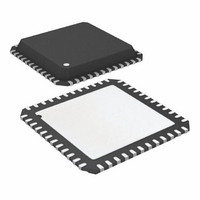ATA6613P-PLQW Atmel, ATA6613P-PLQW Datasheet - Page 246

ATA6613P-PLQW
Manufacturer Part Number
ATA6613P-PLQW
Description
MCU W/LIN TXRX REG WTCHDG 48-QFN
Manufacturer
Atmel
Series
AVR® ATA66 LIN-SBCr
Datasheet
1.ATA6612-EK.pdf
(364 pages)
Specifications of ATA6613P-PLQW
Core Processor
AVR
Core Size
8-Bit
Speed
16MHz
Connectivity
I²C, LIN, SPI, UART/USART
Peripherals
Brown-out Detect/Reset, POR, PWM, WDT
Number Of I /o
23
Program Memory Size
16KB (16K x 8)
Program Memory Type
FLASH
Eeprom Size
512 x 8
Ram Size
1K x 8
Voltage - Supply (vcc/vdd)
2.7 V ~ 5.5 V
Data Converters
A/D 8x10b
Oscillator Type
Internal
Operating Temperature
-40°C ~ 125°C
Package / Case
48-QFN Exposed Pad
Processor Series
ATA6x
Core
AVR8
Data Bus Width
8 bit
Data Ram Size
1 KB
Interface Type
I2C, SPI, USART
Maximum Clock Frequency
16 MHz
Number Of Programmable I/os
23
Number Of Timers
3
Maximum Operating Temperature
+ 125 C
Mounting Style
SMD/SMT
Minimum Operating Temperature
- 40 C
On-chip Adc
10 bit, 8 Channel
Lead Free Status / RoHS Status
Lead free / RoHS Compliant
Available stocks
Company
Part Number
Manufacturer
Quantity
Price
Company:
Part Number:
ATA6613P-PLQW
Manufacturer:
ATMEL
Quantity:
5 000
Part Number:
ATA6613P-PLQW
Manufacturer:
ATMEL/爱特梅尔
Quantity:
20 000
- Current page: 246 of 364
- Download datasheet (7Mb)
6.19.8
6.19.8.1
246
Atmel ATA6612/ATA6613
Transmission Modes
Master Transmitter Mode
The TWI can operate in one of four major modes. These are named Master Transmitter (MT),
Master Receiver (MR), Slave Transmitter (ST) and Slave Receiver (SR). Several of these
modes can be used in the same application. As an example, the TWI can use MT mode to
write data into a TWI EEPROM, MR mode to read the data back from the EEPROM. If other
masters are present in the system, some of these might transmit data to the TWI, and then SR
mode would be used. It is the application software that decides which modes are legal.
The following sections describe each of these modes. Possible status codes are described
along with figures detailing data transmission in each of the modes. These figures contain the
following abbreviations:
S: START condition
Rs: REPEATED START condition
R: Read bit (high level at SDA)
W: Write bit (low level at SDA)
A: Acknowledge bit (low level at SDA)
A: Not acknowledge bit (high level at SDA)
Data: 8-bit data byte
P: STOP condition
SLA: Slave Address
In
TWINT Flag is set. The numbers in the circles show the status code held in TWSR, with the
prescaler bits masked to zero. At these points, actions must be taken by the application to
continue or complete the TWI transfer. The TWI transfer is suspended until the TWINT Flag is
cleared by software.
When the TWINT Flag is set, the status code in TWSR is used to determine the appropriate
software action. For each status code, the required software action and details of the following
serial transfer are given in
prescaler bits are masked to zero in these tables.
In the Master Transmitter mode, a number of data bytes are transmitted to a Slave Receiver
(see
transmitted. The format of the following address packet determines whether Master Transmit-
ter or Master Receiver mode is to be entered. If SLA+W is transmitted, MT mode is entered, if
SLA+R is transmitted, MR mode is entered. All the status codes mentioned in this section
assume that the prescaler bits are zero or are masked to zero.
Figure 6-89 on page 249
Figure 6-88 on page
247). In order to enter a Master mode, a START condition must be
Table 6-90 on page 248
to
Figure 6-95 on page
to
259, circles are used to indicate that the
Table 6-93 on page
258. Note that the
9111H–AUTO–01/11
Related parts for ATA6613P-PLQW
Image
Part Number
Description
Manufacturer
Datasheet
Request
R

Part Number:
Description:
MCU W/LIN TXRX REG WTCHDG 48-QFN
Manufacturer:
Atmel
Datasheet:

Part Number:
Description:
Ata6613
Manufacturer:
ATMEL Corporation
Datasheet:

Part Number:
Description:
BOARD DEMO LIN-MCM FOR ATA6613
Manufacturer:
Atmel
Datasheet:

Part Number:
Description:
DEV KIT FOR AVR/AVR32
Manufacturer:
Atmel
Datasheet:

Part Number:
Description:
INTERVAL AND WIPE/WASH WIPER CONTROL IC WITH DELAY
Manufacturer:
ATMEL Corporation
Datasheet:

Part Number:
Description:
Low-Voltage Voice-Switched IC for Hands-Free Operation
Manufacturer:
ATMEL Corporation
Datasheet:

Part Number:
Description:
MONOLITHIC INTEGRATED FEATUREPHONE CIRCUIT
Manufacturer:
ATMEL Corporation
Datasheet:

Part Number:
Description:
AM-FM Receiver IC U4255BM-M
Manufacturer:
ATMEL Corporation
Datasheet:

Part Number:
Description:
Monolithic Integrated Feature Phone Circuit
Manufacturer:
ATMEL Corporation
Datasheet:

Part Number:
Description:
Multistandard Video-IF and Quasi Parallel Sound Processing
Manufacturer:
ATMEL Corporation
Datasheet:

Part Number:
Description:
High-performance EE PLD
Manufacturer:
ATMEL Corporation
Datasheet:

Part Number:
Description:
8-bit Flash Microcontroller
Manufacturer:
ATMEL Corporation
Datasheet:











